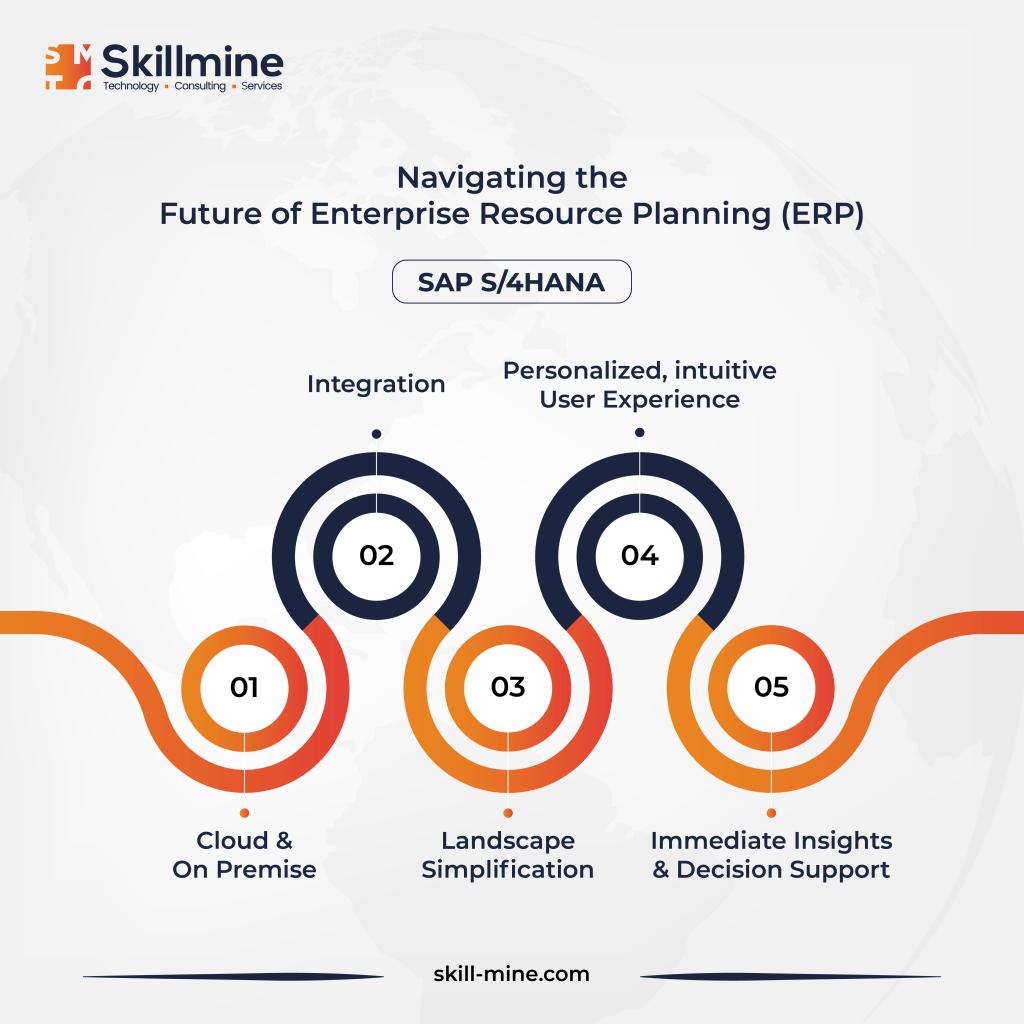The global Enterprise Resource Planning software market is projected to reach 100.7 billion USD by 2025, with SAP as the leading vendor, as per Gitnux.org. 53% of businesses believe ERP is one of the priority sectors for investments. ERP systems are pivotal for streamlined operations, integrating business processes, and enhancing efficiency. Among ERP solutions, SAP stands out as the optimal choice, offering comprehensive modules, real-time insights, and seamless integration. With a robust foundation like SAP, businesses can achieve heightened productivity, improved decision-making, and a competitive edge in dynamic markets.

Features of SAP S/4HANA
S/4HANA transforms ERP by modernizing, speeding up, and simplifying it. This is achieved through a streamlined data model, a lean architecture, and an intuitive user experience using the tile-based SAP Fiori UX.
The integration of advanced technologies like AI, machine learning, IoT, and advanced analytics is seamless in S/4HANA. By harnessing the capabilities of the SAP HANA in-memory database and these cutting-edge technologies, S/4HANA facilitates real-time issue resolution and swift analysis of extensive data sets. The on-premises version of S/4HANA can be deployed on public or private clouds and hybrid environments. In contrast, the multi-tenant SaaS version, SAP S/4HANA Cloud, offers unique modules and features compared to its on-premises counterpart.
Benefits of SAP S/4HANA
Simplifies Business Model Updates
SAP ERP Central Component (ECC) was designed for business models that didn’t need to adapt as rapidly as present-day models, which are evolving to align with various factors such as advanced technologies, customer expectations, supply chain disruptions, and hybrid workforces. However, SAP S/4HANA provides enhanced capabilities for leveraging data and transitioning to new business models, making it easier for companies to implement changes. SAP S/4HANA, being built from the ground up, aligns with the current business landscape. If companies aim to make adjustments, acquire new entities, or explore different sales channels, this platform offers a smoother and faster transition into these new areas.
Streamlines ERP Integration for Acquisitions
In the consumer-packaged goods sector, enterprises often venture into new markets and enhance their product portfolios by acquiring smaller brands. Prior to SAP S/4HANA, incorporating these acquisitions into the core ECC systems was a time-consuming and resource-intensive process. With S/4HANA, businesses now have the flexibility to keep acquisitions on the SAP public cloud, eliminating the need to integrate them directly into the core system.
Reduces Ownership Expenses
S/4HANA incorporates features like Global Available-to-Promise (Global ATP) and master data governance directly into the core. This consolidation results in fewer elements to manage, leading to reduced ownership and maintenance costs from an infrastructure standpoint.
The collaborative infrastructure introduced by S/4HANA allows businesses to shift away from traditional bare-metal infrastructures that necessitate upgrades every five years. According to an SAP survey, companies can achieve an 11% to 17% reduction in IT costs by transitioning from the outdated physical infrastructure to the more cloud-native environment supported by S/4HANA.
Accelerates Analytical Insights
Operating on the HANA in-memory database, S/4HANA significantly enhances performance. Its intelligent data design minimizes aggregate tables and data redundancy, leading to increased efficiency. Instead of storing data in a separate warehouse and waiting for loading, the core ERP software system delivers analytics and faster insights.
Having business transactions and analytics capabilities within the same system also expedites insights. This allows businesses to swiftly make decisions and execute business processes in a single application using a unified source of information, eliminating the need to switch between systems and applications. This integration results in substantial efficiency gains and time savings.
Enhances Forecast Accuracy
In S/4HANA, embedded AI and machine learning applications are gradually advancing to refine modeling, predictive outcomes, and forecasting. Consider a retail scenario where the Universal Data Element Framework is employed for demand forecasting based on historical data, incorporating external factors like weather. With this approach, the retailer can construct a model capable of predicting the demand for a specific product in a designated region.
Expedites Period-End Closures
In the financial realm, a swifter database in S/4HANA translates to quicker end-of-period closings. Companies can now reconcile their accounting in real time, receiving reports that provide an up-to-date financial snapshot. Additionally, S/4HANA enables businesses to engage in predictive accounting by harnessing AI and machine learning technologies.
Proactive Asset Maintenance
Leveraging the in-memory database, Machine Learning, and AI, companies can integrate industrial IoT sensors with S/4HANA for predictive analytics, especially on the manufacturing shop floor. This integration enables the constant monitoring of assets, with sensors working 24/7 to track vibration, temperature, and movement. Based on baseline measurements, companies can predict maintenance needs or potential malfunctions, preventing costly repairs or unexpected shutdowns.
Streamlines User Interface
While SAP retained its Graphical User Interface (GUI), a familiar interface for over two decades, it underwent a redesign in S/4HANA to better align with enhanced business processes. Additionally, companies can utilize the SAP Fiori user interface, an HTML5-based (SAPUI5) platform integrated into S/4HANA or available as a standalone module. This interface facilitates standard business tasks on iOS and Android devices.
Task Automation
S/4HANA offers light process automation, empowering organizations to automate routine tasks like running reports that were traditionally handled manually. This automation frees up employees to concentrate on more impactful activities. Additionally, businesses can incorporate robotic process automation tools to expedite and streamline various business processes.
Conclusion
Migrating to S/4HANA allows enterprises to enhance flexibility by seamlessly incorporating new business acquisitions, adopting proactive asset monitoring strategies, and eliminating mundane tasks from their employees’ daily workload. Skillmine’s SAP technologists are specialized in SAP S/4HANA implementation and testing solutions. Leveraging our expertise across various industries and a deep understanding of business needs, we are well-equipped to support you.
Looking for expert technology consulting services? Contact us today.





